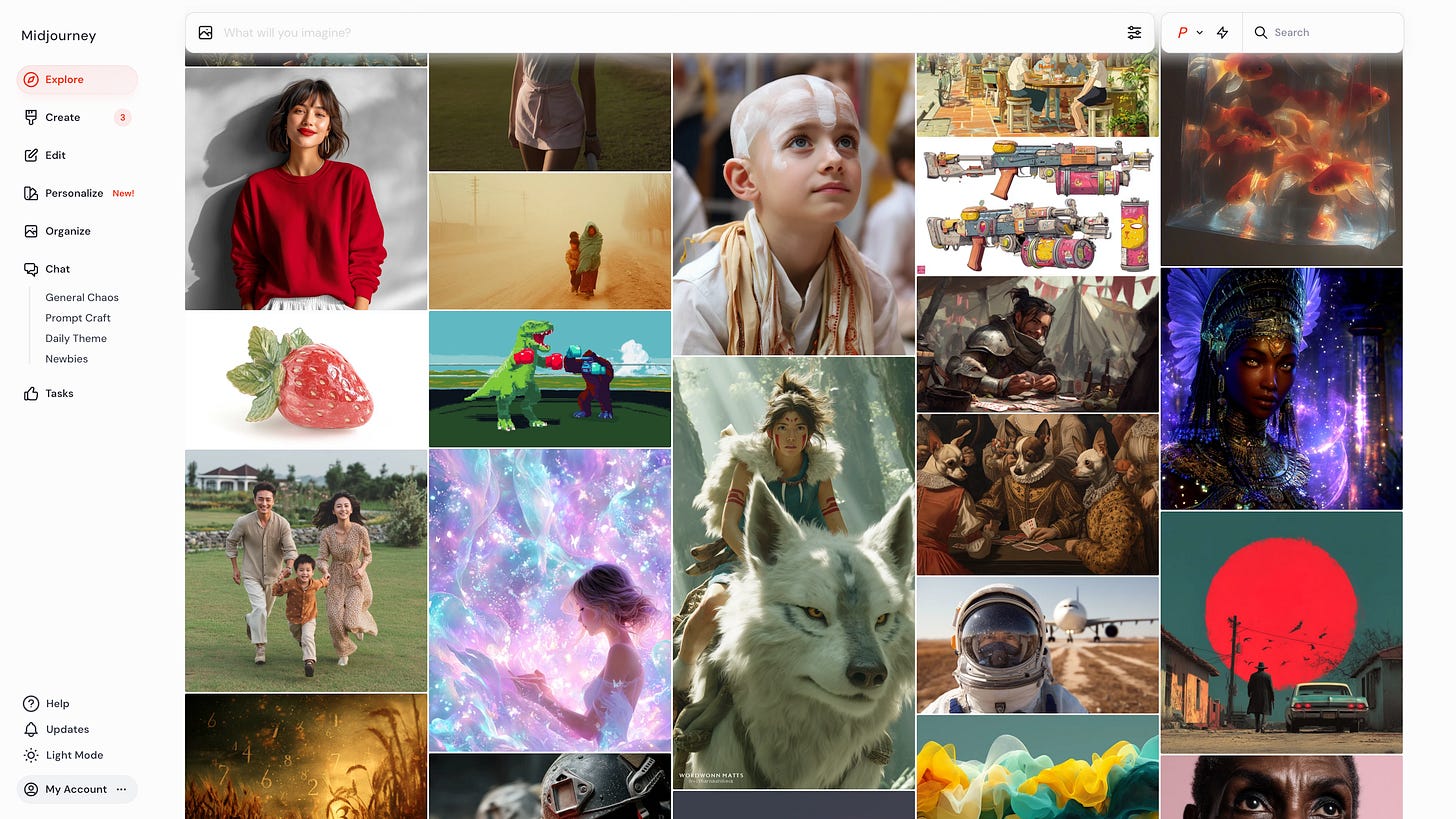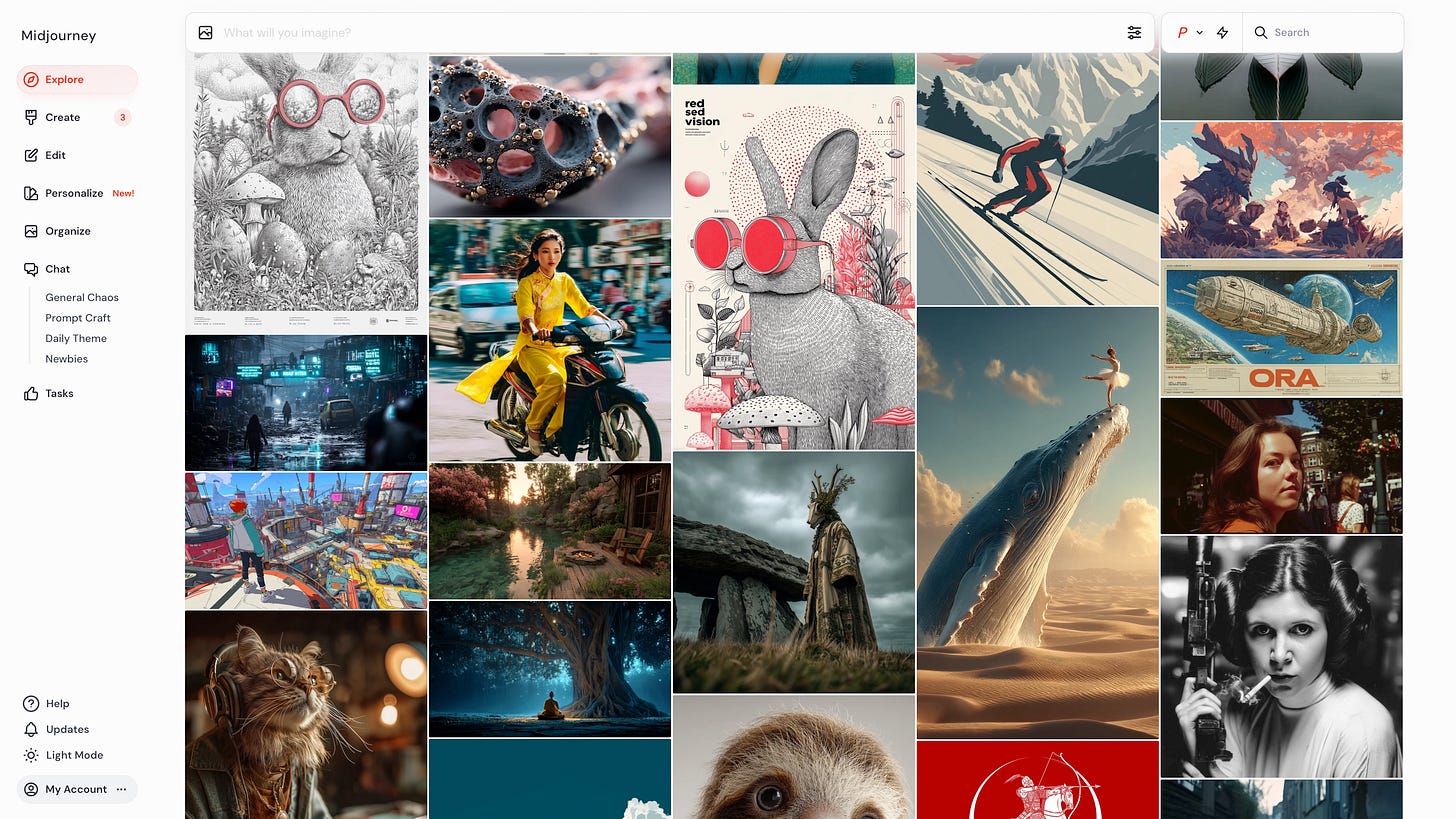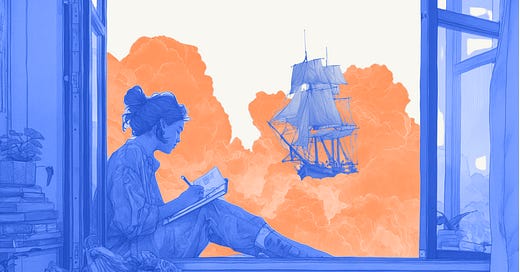Midjourney as a Portal Into Collective Imagination
As language becomes an image and machines begin to co-create, our creative process evolves. This reflection explores how generative AI tools are transforming the way we imagine, design, and build.
Hey friends,
I’ve been meaning to write about this for a while.
One of the tools I keep coming back to—again and again, often without a clear reason—is Midjourney. It’s hard to describe exactly what it is: part AI art generator, part collective imagination machine, part creative rabbit hole. But more than anything, it’s become a place I go to think in images.
Here’s a short reflection on what Midjourney means to me, how I use it in my work, and why I think it tells us something important about the future of creativity.
Enjoy
(For anyone new to it—Midjourney is a generative AI tool where you write a short text prompt, and it creates vivid, often stunning visuals. Launched in 2022 by a small, independent team led by David Holz, Midjourney quickly stood out from other image generators like DALL-E and Stable Diffusion with its distinctive style, strong community, and beautifully chaotic "Explore" feed. With the recent release of V7—powered by an entirely new engine—the tool now produces higher-quality results faster than ever, giving users the ability to generate almost anything with uncanny depth and coherence. It’s not just about aesthetics—it’s about exploration, expression, and access.
We used to think of the future as a fixed destination—something to predict or prepare for. But increasingly, it feels more like a collaborative fiction. A layered, shifting narrative we co-create through words, code, images, and ideas.
Midjourney sits squarely in this space. It’s not just a generative tool—it’s a shared imagination engine. A surreal sketchbook of the internet’s collective dreams. For me, it’s become more than just a creative playground. It’s a daily ritual, a thinking partner, and a provocateur.
Oscar Wilde said that some things are too important to be taken seriously. Art is one of those things. Setting the bar low, especially to get started, frees you to play, explore, and test without attachment to results.
― Rick Rubin, The Creative Act: A Way of Being
I often begin with no goal in mind. Just the “Explore” tab—Midjourney’s living, breathing mosaic of visual thought. It’s like peering into a hive mind: ancient ruins on alien planets, posthuman cityscapes, glitched-out fairy tales, contemplative illustrations, and countless forms of cats in every imaginable style. Some days, I’m hunting for robots to inspire a project. Other times, I get lost in sweeping landscapes or poetic visual metaphors, letting randomness find me.
From there, the prompts begin. One phrase turns into five. Styles shift. Unexpected artists emerge from the dataset. I play with language and syntax, watching how a single adjective transforms the mood. There’s this exhilarating sense of speed—your thoughts become images within seconds. It’s fast, iterative, and often bizarre in the best way.
Some styles become trends—Studio Ghibli-inspired fantasy, stylized action figures, cinematic 35mm shots—and they’re wildly popular in both Midjourney and ChatGPT prompt communities. But the true power of AI image generation lies far beyond the current hype. Midjourney, in particular, reveals that we're not just replicating styles—we're experimenting with new forms of seeing and storytelling. With a single tool, you can render photorealism, vintage lithographs, comic panels, architectural blueprints, or surrealist dreamscapes with astonishing quality. This breadth turns it into something much larger than a style machine. It becomes a canvas for vast, flexible, deeply personal exploration. That’s what makes it revolutionary—and a signal for how we might use language-based tools more powerfully across the board.
Co-Creating with Machines: My Workflow
Lately, I’ve also been experimenting more with ChatGPT—not just for prompts but for writing, planning, and concept development. It’s amazing in a different way: fast, collaborative, and often unexpectedly deep. But there’s one thing I miss—there’s no “Explore” section. No serendipitous scroll through others’ thoughts or creations. With Midjourney, discovery is communal. With LLMs, it’s often more internal and self-driven.
I use Midjourney to generate graphics and visual elements for my writing. It's part inspiration board, part visual sketchpad. I often experiment with styles, browse the Explore section for references, and dive deep into different artworks and their associated prompts to understand what makes them compelling.
Sometimes, I write prompts by hand, refining them through trial and error. Other times, I co-create prompts with the help of large language models like ChatGPT or Claude, using them as partners in clarifying mood, composition, or even emotional tone.
Midjourney is woven into several phases of my creative process. It starts as a spark—helping me explore directions for visual identity, mood boards, or conceptual storytelling. I use it when I prototype ideas for speculative products, illustrate narrative scenarios, or push my thinking into unfamiliar aesthetic or thematic territories. Even when I’m not designing something specific, it helps me think more visually and metaphorically—something no traditional tool ever gave me.


What AI Art Reveals (About Us)
Midjourney doesn’t just generate content—it invites interpretation. And sometimes, it surprises you with what you find.
It raised bigger questions, too: Are tools like Midjourney helping us express new ideas—or just making it easier to remix what's already been done? When creativity becomes this frictionless, what do we gain—and what might we lose?
And still, what I find most profound is how Midjourney blurs the line between seeking and discovering. You’re not just creating an image—you’re excavating possibilities. Testing aesthetics. Composing futures. It’s like dreaming aloud with a machine that listens and responds creatively.
There’s a wildness to it all. A beautiful unpredictability. But it also comes with questions: Where does authorship live in this process? Are we discovering something truly new—or remixing deeper cultural memory? Does faster always mean better?
I don’t have answers. But I know this: Tools like Midjourney shift how we imagine. They stretch the edges of what’s possible—not by replacing our creativity but by refracting it through enhanced logic. They invite us to co-author the future with machines—and with each other.
And that, to me, is the real fantasy. Not escape—but expansion.
Want to try it yourself? Take one of your dreams or memories and run it through Midjourney.
Or, remix this prompt:
Create a painting in the style of the artist John Rossel. Create a dual composition: A soft scarf lying on a chair, with a fading warm glow in the shape of a cat above it, symbolizing a recent loss, a metaphorical everyday moment, or emotional silence. A luminous mist envelops everything. In bright translucent colors.
Or this one
A floating apartment with a balcony turned into a small open-air market stall, flickering neon sign "open", soft warm light from the window inside, jars and strange glowing tech sold on the railings, other floating buildings hovering nearby in fog, purple-grey sky with gentle blue glow above, ambient cyberpunk calm, retro-futuristic cinematic scene, photorealistic.
Or this one
A young Tokyo female cyborg, in the style of a cyborg, robotic hand, sitting on a chair, profile shot, using a screwdriver to fix her fashionable robotic arms with pink color and cartoon sticker on it, in the bedroom, in the style of pop kei, joong keun lee, playful yet macabre, photo-realistic hyperbole. Candid photo. schoolgirl lifestyle
Or something simple like
woman sleeping in bed between jungle leaves, aerial view
What shows up for you?
So, what future are you imagining?
Let me know in the comments. Or share your favorite Midjourney prompt or an amazing AI generative tool for visuals you’ve recently discovered—I’d love to see what you’re creating ✨
Remember, you can always send me a DM!
If you enjoyed this post, hit the 🧡, share it with someone exploring AI-powered product building, or leave a comment —I’d love to hear what you’re experimenting with.






The sref code feature page of Midjourney is also very useful. I often use this feature to gain inspiration and recommend this website resource. https://midjourneysref.com/
I find myself using Midjourney in a similar way - as a visual thinking tool rather than just an image generator. What's fascinating is how it serves as both a creative catalyst and a reflection of our collective imagination. The "Explore" feed has become this remarkable pulse-check on our shared visual language(and BTW. back in the early days - all we had was Discord Chat, so this is really well-thought!).
What I've found most valuable is using it early in the concept development phase for digital projects - it helps bridge the gap between abstract ideas and concrete visualization, especially when collaborating with cross-functional teams. I've explored this intersection between AI tools and creative workflows in my recent exploration of building practical digital solutions: https://thoughts.jock.pl/p/csv-column-stripper-affordable-ecommerce-data-solution